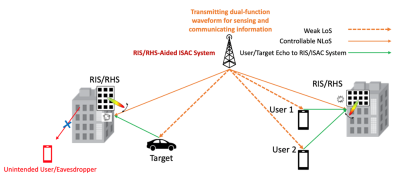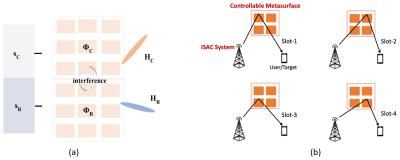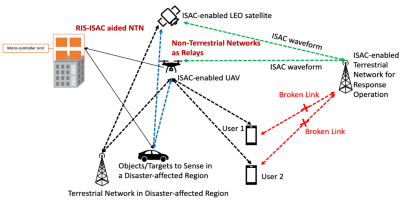Aryan Kaushik, University of Sussex, UK, Yonina C. Eldar, Weizmann Institute of Science, Israel, and Octavia A. Dobre, Memorial University of Newfoundland, Canada
Published: 30 Apr 2023

CTN Issue: April 2023
A note from the editor:
Network evolution toward high frequency spectrum technologies such as millimeter wave and sub-terahertz not only quench the thirst for more communication bandwidth, but also for higher sensing fidelity. Integrated (joint) sensing and communication (ISAC) enable hardware and spectrum reuse between sensing and communication functions, allowing dual-function green networks to be built on cost-effective hardware. In the April issue of CTN, Profs. Kaushik, Eldar and Dobre take a multi-layer snapshot of this burgeoning area of research, highlighting impacts of emerging technologies such as reconfigurable intelligent (or holographic) surface, energy-efficient beamforming, and novel multiple access schemes. The multidisciplinary nature of ISAC is amply illustrated by the diverse applications it has found itself in, as well as the comprehensive up-to-date references. Read on, savor the prospect of novel applications that are emerging, and some that have not yet come to pass. As usual, your thoughts and feedback are most appreciated.
Xiao Feng Qi, CTN Associate Editor
Integrated Sensing and Communications for Evolution of Next Generation Networks



Roadmap to Next Generation Networks
The fifth generation (5G) subscriptions are forecast to reach 5 billion by 2028 which indicates faster uptake growth than previous generation standards due to large scale deployments of the early 5G standard [1]. Three 5G spectrum bands, i.e., low-band (frequency division duplex, below 7 GHz), mid-band (time division duplex, below 7 GHz), and high-band (millimeter wave (mmWave), above 24 GHz), are being exploited by different countries in the race of 5G deployment depending on spectrum availability. For example, the US is approaching all three bands, the UK low- and mid-band while South Korea mid-band only [1]. Spectrum availability is of paramount importance while deploying the next generation of wireless standards such as 5G Advanced and sixth generation (6G). The Third-Generation Partnership Project (3GPP) latest Release 18 indicates new radio (NR) mobility and radio frequency (RF) enhancements, and NR dynamic spectrum sharing (DSS) enhancements [2]. The design of 5G NR, which presents unified and scalable air interface allowing co-existence of a wide range of 5G device classes, has been scaled to support 60 GHz unlicensed band with prioritized expansion of mmWave to 71 GHz in Release 17 [3].
High frequency spectrum technologies such as mmWave, i.e., from 30 GHz-300 GHz, sub-terahertz (THz) and THz offer more bandwidth than what was available with previous generation standards which intends to meet ever-growing user demands. There are several cons with high frequency channel models such as high path loss, blockage effects and majorly line-of-sight (LoS) communications while pros indicate the fulfilment of spectrum demand from service providers to accommodate high channel capacity and fast data rates. In early 5G deployments, the worldwide community has been concerned with spectrum availability since the RF/sub-6 GHz spectrum we currently use is overly congested. With the projection of mobile data traffic increasing significantly, advanced spectrum sharing solutions are required to make smart use of the available spectral resources. Simultaneously, the main use cases of ultra-reliable low-latency communication (URLLC), enhanced mobile broadband (eMBB) and massive machine type communication (mMTC) need to be explored well enough while fulfilling the demands of spectrum sharing in next generation wireless standards.
Why Do We Need Integrated Sensing and Communications? Trends and Challenges
While massive connectivity and high data speed are required for 5G Advanced and 6G, low cost and energy-efficient solutions present ‘need of the hour’. Achieving high data rates, long-term spectrum planning and harnessing are envisioned to be one of the fundamental technologies in 6G mobile communications [4]. Moreover, an intelligent reuse of the available hardware intertwined with the spectrum sharing concept can lead to an important solution for next generation networks. The United Nations (UN)’s sustainable development goals such as “affordable and clean energy”, “sustainable cities and communities”, and “industry, innovation and infrastructure,” will influence next generation wireless technologies to be cost-efficient and sustainable by sharing the available resources such as spectrum and hardware.
Integrated sensing and communication (ISAC) technology provides a dual-function potential solution for 5G Advanced and 6G systems towards efficient use of hardware and spectral resources, while decongesting the crowded sub-6 GHz spectrum used for most of the mobile communication applications [5]-[10]. The basic principle of ISAC is to unify sensing and communications operations on a single hardware while using the same spectral resources. As we know sensing collects and extracts information, such as target detection in the case of radar sensing, and using radio waves for tracking movement, while communication possesses transfer of information. A special case of ISAC technology is joint radar-communications (JRC) system where sensing is performed by a radar [11]. A prime advantage of implementing this dual-function JRC system is the wide availability of radar spectrum [12] which can be potentially used for communication operations as well. Furthermore, JRC systems can be implemented at high frequency spectrums such as mmWave and THz since high frequency bands create narrow beams for transmission and reception of signals. For instance, mmWave frequencies above 28-30 GHz range can be deployed for JRC systems. Furthermore, with few multipath components in the mmWave band, radar echo may experience less clutter interference in comparison to the sub-6 GHz bands [13]. It is expected that mmWave technology will equip favourable sensing functionality which may be applied to vehicular communication scenarios [14], [15], e.g., 77 GHz is used for automotive radar in driverless cars. The benefits of implementing mmWave in JRC systems and related signal processing approaches have been discussed in [16].
JRC systems are primarily categorized into three categories [5]: (i) communication-centric JRC which implements radar sensing as the secondary function of the existing communication system, (ii) radar-centric JRC which integrates wireless communication as the secondary function of the existing radar system, and (iii) joint JRC that offers tunable trade-off between both operations [17]. The usage of dual-function JRC systems have attracted significant attention from the research and development community. With robust ISAC functionalities, we are escalating towards achieving hyper-connectivity in 5G Advanced and 6G networks leading to future multi-function devices that can enable ultra-reliability and massive connectivity such as integrated sensing, localization and communications (ISLAC), and integrated sensing, computing and communications (ISCC). In the following, we present advances in some of the key enabling technologies for ISAC which are envisioned to be prominent enablers required in the quest of next generation standardization.
Reconfigurable Intelligent and Holographic Surfaces Aided ISAC
intelligent metasurfaces have attracted wide attention in communication systems, due to their low complexity and energy efficiency characteristics. Reconfigurable intelligent surfaces (RIS) leverage smart radio surfaces with high number of small antennas or metamaterial elements based on a programmable structure that can be used to control the propagation of electromagnetic waves [18]-[20]. The reflection of EM waves makes RIS highly compatible with the transceiver antenna setup which can provide high capacity and coverage while benefitting from its energy-efficient characteristics. RIS configurations may be realized by incorporating a large number of antenna elements with reconfigurable processing networks which provides a continuous antenna aperture. Fig. 1 shows a wireless transceiver operation employing an RIS setup for controllable non line-of-sight (NLoS) path which can be used for a weak LoS link specially at high frequency bandwidth such as at mmWave, sub-THz and THz frequencies.
RIS configurations can be based on passive or active elements, where passive RIS does not consume any direct-current power practically due to no amplification of the dynamically steered signal while active RIS employs an active reflection-type amplifier for amplification of the reflected signal [21], [22]. In the direction of advancements in RIS, an Industry Specification Group (ISG) on RIS has been formed by ETSI to identify use cases and deployment scenarios [23]. The latest technical advancements in RIS can be directly or adjacently integrated with ISAC to further enhance the overall system performance assuming that RIS type solutions can indeed be created to perform as the theory predicts. In terms of practical experimentation, MIT’s RFocus prototype performs beamforming using a large number of passive antennas [24], while NTT DOCOMO has presented a transparent dynamic metasurface which enables dynamic control of transmission/reflection ratio [25].


In the case of reconfigurable holographic surfaces (RHS), the transceiver may leverage a hologram principle with for efficient communications and networking applications. The radio meta-surface of RHS-aided transceiver does not require extra control unit to phase-shift the holographic transmit signal [26]. Both RIS and RHS configurations can be applied across the radio spectrum, from sub-6 GHz to mmWave through to THz frequencies with massive antenna connectivity. Conformal metasurfaces have been also considered for vehicular scenarios with cylindrical-RIS structures [27].
The implementation of RIS aided ISAC systems has started to gain significant attention among researchers [28]-[32]. There has been recent progress in RHS aided ISAC systems where sensing and communication performance is enhanced by realizing holographic beamforming through metamaterial antennas for advanced controllability of the beampattern [33], [34]. Fig. 2 shows that RIS/RHS aided ISAC systems can achieve dynamic beamforming for the dual-function waveform which reaching non-line-of-sight (NLoS) users and targets quite effectively. Fig. 3 (a) shows intelligent metasurfaces aided ISAC system taking into account the impact of interference from sensing operation over the communication operation and vice-versa. A subset selection based solution for RIS-aided ISAC is presented in [30] taking into account the interference from one operation over the other, where Fig. 3 (a) corresponds to the considered system which is composed of an N-element RIS assisting downlink communication between a base-station and user (UE), where sC is the communication part of the signal, sR is radar signal component, ΦC and ΦR are the diagonal matrices with the complex reflection (constant modulus elements) of the RIS for the communications and radar operations, respectively, and HC and HR are the channel matrices for the communications and radar, respectively.

Fig. 3 (b) shows a basic illustration of low complexity intelligent training via sub-surfaces of the whole controllable metasurface in different transmission slots towards a mobile user or target. Recent advancements in RIS based 6G techniques are shown in [35] and RIS-aided ISAC systems can be observed in [36], [37]. Artificial intelligence (AI) based passive RIS-assisted ISAC has also attracted attention recently in order to estimate the channel for dual function transmission [38].
Energy Efficient Beamforming for ISAC
One of the unconventional characteristics of ISAC networks is to implement a dual-function system which is able to perform both sensing and communication operations, and mutually benefit from real time performance of both the individual systems. Unlike radar-communication coexistence (RCC) scenario, dual-function JRC systems do not require extensive co-ordination between radar and communication entities since dual-function transmission signal is adopted. ISAC systems result in saving of hardware and spectral resources however there is further interest from the research and development community on designing energy efficient ISAC networks. Analog architectures have been recently implemented for green ISAC [39], [40]. In addition, hybrid beamforming which employs fewer number of RF chains than the number of transceiver antennas is a highly potential candidate for ISAC systems [41].
Hybrid beamforming based ISAC has gained recent attention with dynamic algorithms which lead to optimal RF chain optimization reducing the number of RF chains even further than conventional fixed RF chain beamformers [42] and optimal RF chains with low resolution quantizers (i.e., optimal bit allocation) resulting in energy efficient ISAC systems [43], [44]. Partially-connected hybrid beamforming can be also explored for ISAC design such as in [45]. There has also been recent focus on exploiting mutual information of the radar sensing part along with data rate for communication operation such as in [8], [46], and on interference exploitation between both the operations such as in [8], [30], [47]. Index modulation with different beamforming approaches have also been introduced to enable different agilities in the design of ISAC systems [7], [48]-[50].
Next Generation Multiple Access (NGMA) for ISAC
Besides green ISAC, in the era of massive connectivity for enhanced mobile broadband it is vital to employ next generation multiple access (NGMA) approaches to execute ISAC functionalities while managing interference. In this direction, rate-splitting multiple access can be considered for multi-user communication and radar sensing under imperfect channel state information while optimizing the number of RF chains and low-resolution sampling setup [51]. RSMA has been further explored in the context of low Earth orbit (LEO) satellites [52] which is one of the most important enabling technologies in next generation communications under the realm of non-terrestrial network (NTN) internet-of-things (IoT) as was also highlighted in the latest 3GPP releases [53].

Non-orthogonal multiple access (NOMA) which surpasses conventional orthogonal multiple access based schemes can also be effective for interference management in ISAC designs [54], [55]. However, we are heading towards advanced solutions where new multiple access schemes are being originated such as in the case of RIS-indexed multiple access [35] which can be very well explored for the case of ISAC systems.
There has been significant interest from various fields of 5G Advanced and 6G research and development in ISAC, resulting in ISAC being a multidisciplinary research area with multifunctional capabilities: ISAC-assisted mobile edge computing [56], underwater fibre optic cables enabled ISAC [57] and ISAC in an optical fibre for enhanced transmission performance [58], ranging performance gains of light detection and ranging (LiDAR) using ISAC [59], vehicular communication networks with ISAC functionalities [60], industrial IoT executed by orthogonal time-frequency space (OTFS) waveform based ISAC [61], localization intertwined with ISAC functionalities for 6G [62], and many more ISAC oriented applications. Under the realm of IEEE Future Directions, there has been a recent IEEE Public Safety Technology (PST) Initiative to focus on the latest technologies that can play a vital role in public safety and several related applications. In NTN, flying platforms such as unmanned aerial vehicles (UAVs) can act as relays and enable ISAC functionalities [63]. Dual-function ISAC can be deployed into an NTN scenario where UAV and LEO satellites act as relays which are enabled with ISAC functionalities, and RIS can further enhance the smart radio environment application for disaster management and public safety, as shown in Fig. 4 above.
To conclude, ISAC-enabled deployment configurations and key technology enablers of ISAC will play a significant role in 5G Advanced and 6G-envisioned systems and networks. In the quest for standardization of next generation networks, ISAC is becoming a key component enabling savings of resources, and paving the way to multiple new applications. As industry and academia work towards the advancements in ISAC, many more applications will emerge that will enable holistic growth of next generation systems and networks.
References
- Ericsson Mobility Report 2022, pp. 1-40, Nov. 2022. [Available: https://www.ericsson.com/4ae28d/assets/local/reports-papers/mobility-report/documents/2022/ericsson-mobility-report-november-2022.pdf]
- 3GPP Release 18 [Available: https://www.3gpp.org/specifications-technologies/releases/release-18]
- 5G NR Release 17 [Available: https://www.qualcomm.com/research/5g/5g-nr]
- 5G Americas White Paper: Mobile Communications Towards 2030, pp. 1-56, Nov. 2021.
- J. A. Zhang et al., “An Overview of Signal Processing Techniques for Joint Communication and Radar Sensing,” IEEE J. Sel. Topics Sig. Process., vol. 15, no. 6, pp. 1295-1315, Nov. 2021.
- J. Wang et al., “Integrated Sensing and Communication: Enabling Techniques, Applications, Tools and Data Sets, Standardization, and Future Directions,” IEEE Internet of Things J., vol. 9, no. 23, pp. 23416-23440, Dec. 2022.
- T. Huang et al., “MAJoRCom: A dual-function radar communication system using index modulation,” IEEE Trans. Sig. Process., vol. 68, pp. 3423-3438, May 2020.
- A. Kaushik et al., “Towards 6G: Spectrally efficient joint radar and communication with RF selection, interference and hardware impairments,” IET Sig. Process., vol. 16, no. 7, pp. 851–863, Sept. 2022.
- F. Liu et al., “Integrated Sensing and Communications: Towards Dual-functional Wireless Networks for 6G and Beyond,” IEEE J. Sel. Areas Commun., vol. 40, no. 6, pp. 1728-1767, June 2022.
- F. Liu et al., “Seventy Years of Radar and Communications: The Road from Separation to Integration,” arXiv:2210.00446, Oct. 2022.
- D. Ma et al., “Joint Radar-Communications Strategies for Autonomous Vehicles,” IEEE Trans. Sig. Process., vol. 37, no. 4, pp. 85-97, July 2020.
- H. Griffiths et al., “Radar spectrum engineering and management: Technical and regulatory issues,” Proc. IEEE, vol. 103, no. 1, pp. 85-102, Jan. 2015.
- H. Wymeersch et al., “5G mmWave positioning for vehicular networks,” IEEE Wireless Commun., vol. 24, no. 6, pp. 80-86, Dec. 2017.
- J. A. Zhang et al., “Multibeam for joint communication and radar sensing using steerable analog antenna arrays,” IEEE Trans. Veh. Tech., vol. 68, no. 1, pp. 671-685, Jan. 2019.
- S. H. Dokhanchi et al., “A mmWave automotive joint radar-communications system,” IEEE Trans. Aerosp. Electron. Syst., vol. 55, no. 3, pp. 1241-1260, June 2019.
- K. V. Mishra et al., “Toward millimeter-wave joint radar communications: A signal processing perspective,” IEEE Sig. Process. Mag., vol. 36, no. 5, pp. 100-114, Sept. 2019.
- X. Liu et al., “Joint Transmit Beamforming for Multiuser MIMO Communications and MIMO Radar,” IEEE Trans. Sig. Process., vol. 68, pp. 3929-3944, June 2020.
- M. Di Renzo et al., “Communication models for reconfigurable intelligent surfaces: From surface electromagnetics to wireless networks optimization,” Proc. IEEE, vol. 110, no. 9, pp. 1164-1209, Sept. 2022.
- M. Dajer et al., “Reconfigurable intelligent surface: design the channel – a new opportunity for future wireless networks,” Dig. Comms. Netw., vol. 8, no. 2, pp. 87-104, Apr. 2022.
- N. Shlezinger et al., “Dynamic Metasurface Antennas for 6G Extreme Massive MIMO Communications,” IEEE Wireless Commun. Mag., vol. 28, no. 2, pp. 106-113, Apr. 2021.
- Z. Zhang et al., “Active RIS vs. Passive RIS: Which Will Prevail in 6G?,” arXiv:2103.15154, Jan. 2023.
- G. C. Alexandropoulos et al., “Hybrid Reconfigurable Intelligent Metasurfaces: Enabling Simultaneous Tunable Reflections and Sensing for 6G Wireless Communications,” arXiv:2104.04690, Apr. 2021.
- ETSI ISG on RIS Activity Report 2021. [Available: https://www.etsi.org/committee-activity/activity-report-ris].
- V. Arun and H. Balakrishnan, “Rfocus: Beamforming using thousands of passive antennas,” USENIX Symp. Networked Sys. Design and Implementation (NSDI), pp. 1047-1061, 2020.
- NTT DOCOMO, “Docomo conducts world’s first successful trial of transparent dynamic metasurface,” 2020. [Available: https://www.nttdocomo.co.jp/english/info/media_center/pr/2020/0117_00.html].
- C. Huang et al., “Holographic MIMO Surfaces for 6G Wireless Networks: Opportunities, Challenges, and Trends,” IEEE Wireless Commun., vol. 27, no. 5, pp. 118-125, Oct. 2020.
- M. Mizmizi et al., “Conformal Metasurfaces: A Novel Solution for Vehicular Communications," IEEE Trans. Wireless Commun., vol. 22, no. 4, pp. 2804-2817, Apr. 2023.
- X. Wang, et al., “RIS-assisted spectrum sharing between MIMO radar and MU-MISO communication systems,” IEEE Wireless Commun. Lett., vol. 10, no. 3, pp. 594–598, 2021.
- Y. Li and A. Petropulu, “Dual-Function Radar-Communication System Aided by Intelligent Reflecting Surfaces,” arXiv:2204.04721, Apr. 2022.
- E. Vlachos and A. Kaushik, “Subset Selection Based RIS-Aided Beamforming for Joint Radar-Communications,” IEEE Wireless Commun. Netw. Conf. (WCNC) Workshop, pp. 1-6, Mar. 2023.
- L. Zhuoyang et al., “Hybrid RIS-Assisted MIMO Dual-Function Radar-Communication System,” arXiv:2303.16278, Mar. 2023.
- R. S. P. Sankar et al., “Beamforming in Integrated Sensing and Communication Systems with Reconfigurable Intelligent Surfaces,” arXiv:2206.07679, June 2022.
- H. Zhang et al., “Holographic Integrated Sensing and Communication,” IEEE J. Sel. Areas Commun., vol. 40, no. 7, pp. 2114-2130, July 2022.
- H. Zhang et al., “Holographic Integrated Sensing and Communications: Principles, Technology, and Implementation," IEEE Commun. Mag., pp. 1-7, Feb. 2023.
- R. Singh et al., “Indexed Multiple Access with Reconfigurable Intelligent Surfaces: The Reflection Tuning Potential,” arXiv:2302.07476, Feb. 2023.
- M. Hua, “Secure Intelligent Reflecting Surfaces Aided Integrated Sensing and Communication,” arXiv:2207.09095, Jul. 2022.
- S. P. Chepuri et al., “Integrated Sensing and Communications with Reconfigurable Intelligent Surfaces,” arXiv:2211.01003, Nov. 2022.
- Y. Liu, et al., “Deep-Learning Channel Estimation for IRS-Assisted Integrated Sensing and Communication System,” IEEE Trans. Veh. Tech., pp. 1-14, Dec. 2022.
- A. Kaushik et al., “Waveform Design for Joint-Radar Communications with Low Complexity Analog Components,” IEEE Int. Symp. Joint Commun. Sensing (JC&S), pp. 1-5, Mar. 2022.
- K. Wu et al., “Green Joint Communications and Sensing Employing Analog Multi-Beam Antenna Arrays,” IEEE Commun. Mag., pp. 1-7, Feb. 2023.
- E. Vlachos and A. Kaushik, “Covariance-Based Hybrid Beamforming for Spectrally Efficient Joint Radar-Communications,” IEEE Int. Conf. Commun. (ICC), pp. 1-6, In Press, May-June 2023.
- A. Kaushik et al., “Hardware Efficient Joint Radar-Communications with Hybrid Precoding and RF Chain Optimization,” IEEE Int. Conf. Commun. (ICC), pp. 1-6, June 2021.
- A. Kaushik, et al., “Green Joint Radar-Communications: RF Selection with Low Resolution DACs and Hybrid Precoding,” IEEE Int. Conf. Commun. (ICC), pp. 1-6, May 2022.
- F. Xi et al., “BiLiMO: Bit-Limited MIMO Radar via Task-Based Quantization,” IEEE Trans. Sig. Process., vol. 69, pp. 6267-6282, Sept. 2021.
- X. Wang et al., “Partially-Connected Hybrid Beamforming Design for Integrated Sensing and Communication Systems,” IEEE Trans. Commun., vol. 70, no. 10, pp. 6648-6660, Oct. 2022.
- C. Ouyang et al., “Integrated Sensing and Communications: A Mutual Information-Based Framework,” arXiv:2208.04260, Aug. 2022.
- J. Mu et al., “Energy-Efficient Interference Cancellation in Integrated Sensing and Communication Scenarios,” IEEE Trans. Green Commun. Netw., vol. 7, no. 1, pp. 370-378, Mar. 2023.
- A. M. Elbir, “Spatial Path Index Modulation in mmWave/THz-Band Integrated Sensing and Communications,” arXiv:2303.12328, Mar. 2023.
- S. Chen et al., “Pre-scaling and Codebook Design for Joint Radar and Communication Based on Index Modulation,” IEEE Global Commun. Conf. (Globecom), pp. 1-5, Dec. 2022.
- D. Ma et al., “FRaC: FMCW-Based Joint Radar-Communications System via Index Modulation,” IEEE Trans. Sig. Process., vol. 15, issue 6, Nov. 2021.
- O. Dizdar et al., “Energy Efficient Dual-Functional Radar-Communication: Rate-Splitting Multiple Access, Low-Resolution DACs, and RF Chain Selection,” IEEE Open J. Comm. Society, vol. 3, pp. 986-1006, June 2022.
- L. Yin et al., “Integrated Sensing and Communications Enabled Low Earth Orbit Satellite Systems,” arXiv:2304.00941, Apr. 2023.
- A. Kaushik and M. Z. Shakir, “Non-Terrestrial Networks: Have We Found that Ultimate Catalyst for Global Connectivity in 6G?,” IEEE ComSoc Technology News (CTN), Dec. 2022.
- X. Mu et al., “NOMA for Integrating Sensing and Communications towards 6G: A Multiple Access Perspective,” IEEE Wireless Commun., pp. 1-8, Jan. 2023.
- Z. Wang et al., “NOMA Empowered Integrated Sensing and Communication,” IEEE Commun. Lett., vol. 26, no. 3, pp. 677-681, Mar. 2022.
- N. Huang et al., “Integrated Sensing and Communication Assisted Mobile Edge Computing: An Energy-Efficient Design via Intelligent Reflecting Surface,” IEEE Wireless Commun. Lett., vol. 11, no. 10, pp. 2085-2089, Oct. 2022.
- S. Chen et al., “Photonic Integrated Sensing and Communication System Harnessing Submarine Fiber Optic Cables for Coastal Event Monitoring,” IEEE Commun. Mag., vol. 60, no. 12, pp. 110-116, Dec. 2022.
- H. He et al., “Integrated sensing and communication in an optical fibre,” Light Sci. Appl., vol. 12, no. 25, Jan. 2023.
- M. Cao et al., “A Unified Waveform for Optical Wireless Integrated Sensing and Communication,” Asia Commun. Photonics Conf. (ACP), pp. 448-452, Nov. 2022.
- X. Cheng et al., “Integrated Sensing and Communications (ISAC) for Vehicular Communication Networks (VCN),” IEEE Internet of Things J., vol. 9, no. 23, pp. 23441-23451, Dec. 2022.
- K. Wu et al., “OTFS-Based Joint Communication and Sensing for Future Industrial IoT,” IEEE Internet of Things J., vol. 10, no. 3, pp. 1973-1989, Feb. 2023.
- C. De Lima et al., “Convergent Communication, Sensing and Localization in 6G Systems: An Overview of Technologies, Opportunities and Challenges,” IEEE Access, vol. 9, pp. 26902-26925, Jan. 2021.
- Z. Fei et al., “Air-Ground Integrated Sensing and Communications: Opportunities and Challenges,” IEEE Commun. Mag., pp. 1-7, Feb. 2023.
Statements and opinions given in a work published by the IEEE or the IEEE Communications Society are the expressions of the author(s). Responsibility for the content of published articles rests upon the authors(s), not IEEE nor the IEEE Communications Society.


